|
“I
have consulted a number of French and foreign archival files (
United
States
Air
Force and Royal Air Force) and gathered together many precise
details (which you will find in italics) that are necessary to
explain and understand the events from my wartime journal.”
Roger
Cornevin-Hayton
Excerpts
from my “Journal of Youth,” May to August, 1944.
June
10, 1944: In the distance, the clock tower in Bursard…
The
bad weather persisted and the black clouds were ominous. Our
gazogene-powered taxi from the Septier house puttered down the
small country road. We saw in the distance the bell tower in the
round roof of the Town Hall that was to be our future home.
Bursard,
a small village located six kilometres from Sées, welcomed us
in the silence of the blue-green countryside, shrouded in mist
from the
Perseigne
Forest
. Long rows of well-aligned white fences
announced the boundaries of the stud farm, “Haras de Bois
Roussel.” where we took refuge in May and June 1940. Our lives
could have proceeded peacefully, like a long, quiet-flowing
river, while waiting for war to pursue its course, but in the
relative calm of our pastoral retreat, an inexplicable unease
seemed to develop around us.
People
had spoken about the establishment of several aerodromes in the
areas of Essay, Lonrai and Semallé, several kilometers away
from our temporary home. It was rumoured that local residents of
these neighbouring villages had been conscripted by the Todt
organization to lay the foundations.
The construction of such aerodromes by the Luftwaffe
could only attract the attention of Allied bombers, who were
always on the alert.
Ventes-de-Bourse,
Mesnil Brout as well as the railway lines at Forges, Vingt
Hanaps, Saint Gervais de Perron and others were the daily
targets of the RAF and USAF.
Each
day brought its share of unexpected events and diversions.
These
were unsettled days. Some days I did not see anything and felt
pretty much in the dark about things. What good would there be
in maintaining a journal? Only one thing, the bad weather and
the formations of planes, passing above the clouds, Allied
aircraft pitted against German fighter planes, especially the
Focke-Wulfs and Messerschmitts based in the surrounding
aerodromes.
The
American Air Force was active by day and the RAF bombed at
night. The incessant noise of the armadas of aircraft passing
over our heads at night disturbed our sleep.
P47s,
with their black and white striped wings, flew over us at very
low altitude and we waved handkerchiefs as a sign of friendship.
We had the impression that the pilot in his cockpit tilted the
wings of his plane so he could see us better and we were filled
with enthusiasm when it seemed he had understood our signals.
The Allied pilots flew very low…possibly at a height of 50
metres. Curiously, they seemed to have taken the town hall as a
point of reference before attacking their prey, in this case the
German fighters preparing to take off.
June
10, 1944
:
We are not alone any more!
On
this day I had the earphones of our rudimentary crystal radio (which
my family made to hear the reports from the BBC) pressed tightly
to my ear. Jean Marin, Robert Schuman, and Pierre Dac were our
heroes. They were in
London
, on the other side of the Channel; it made
us dream. Suddenly, an alarming movement…the moon-shaped face
of a German soldier was pressed against one of the window panes
of our classroom. What had brought him so near?
The
next day, heavy trucks pulling guns, undoubtedly for the DCA,
surprised us as we were eating our lunch. The feldwebel
had reason to be here; it preceded the encampment of a group of
gunners under the lime trees near the town hall. This intrusion
into our quiet countryside filled us with concern.
|
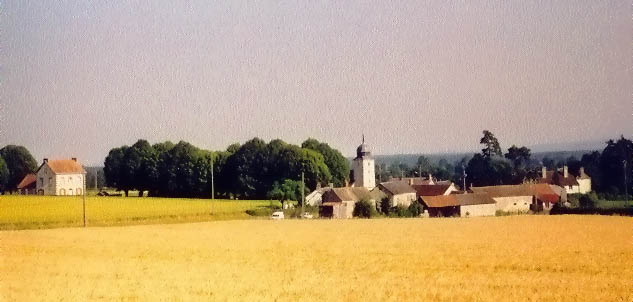
|
|
The small village of Bursard, in the department of Orne. Isolated to the left, the town hall where will live the Cornevin family. She will cohabit some times with the servers of a battery of Flak. Its cannons will come to camouflage themselves under the limes of the alley of the town hall.
|
|
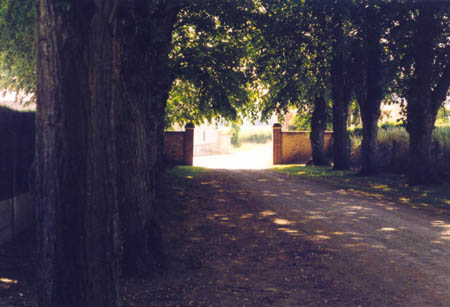
|
Ten
trucks, towing guns covered with camouflage netting, lined up in
the shade of the
tree-lined alley. We realized our peace in this place was over,
knowing this unexpected presence was likely to intensify
attention from Allied aviation. We confirmed
that, if an Allied plane flew low over our heads, any movement
on the ground would draw a burst of fire.
Recovering
from our surprise, we had no alternative than to hide the
unwieldy crystal radio set and the compromising photographs
highlighting the past military service, in the Air Force, of our
cousin who was demobilized in 1940. One photograph represented
his plane, a Potez, on the ground at Auxerre, lost in the middle
of a herd of sheep.

At
that moment, our cousin did not have a plane any more, but his
memories of Africa
had the gift of making me dream. It was the
exotic image of Gao on the
Niger
and the unleashed dreams of desert sands...
What
were the intentions of the non-commissioned officers in this [flak
battery] company? Several days passed.
Each brought its own speculations. The news was like the
weather…good and bad. To our great surprise, our occupying
force tried not to disturb us too much and passed their early
days in the classrooms and the kitchen, without really wanting
to inconvenience us. They had not yet discovered, on the second
floor, my brother’s and my hiding place where were hidden all
the crystal radio sets of the inhabitants of Bursard that were
to be gathered up by order of the Kommandantur.
We did not play in the same places as the grown children;
our passion was hunting with our two dogs for ducks and water
hens on the riverbanks and in the ditches bordered by reeds at
the stud farm at Bois Roussel.
One of the German billets taught us how to identify the
planes from the R.A.F or US Air Force, starting from silhouettes
printed on a booklet. The silhouettes and the characteristics of
these planes flying high in the sky soon held no mystery for us.
One evening, some drunken soldiers started a ruckus in the
courtyard. Prudently we keep our distance…
June
12:
Disappearance of the batteries...
Today,
there were attacks by Mustangs, planes easy to identify with
their square wings. We began to understand the reasons behind
the activity around us. Several aerodromes were under
construction in the surrounding villages. We learned that five
soldiers of the group (who were dispatched to the area around
Essay to get the aircraft ready) were killed or mortally wounded.
A
beautiful morning... relief... without warning, the trucks
disappeared from the village dragging in their wake their
threatening guns. But they set up only a few hundred meters away,
in the green meadows of the stud farm at Bois Roussel, at the
spot called "Les Fontaines." Scarcely visible beneath
the branches, it was very difficult to make them out from our
house, in spite of the fact that the meadows in the south of
Bursard were very open, practically without obstruction. The
thoroughbreds did not seem to be overly disturbed by the
presence of these intruders.
June
13:
A fighter crashed on the railway.
Aerial
combat near Semallé and Neuilly-le-Bisson. Two planes crashed
in a spiral. Nationality unknown.
In fact, one plane was the P47 of Lieutenant Bentley
(originally from
Oregon
) whose
plane, caught by the blast resulting from the explosion of a
rail car, struck the railway line at Vingt Hanaps. The burned
body of the pilot remained there for a long time. Mr. Bernard
Pottier of Neuilly de Bisson has personal mementos and wishes to
return them to the family of Lt. Bentley, or his descendants.
June
17:
The ground of Essay becomes a target...
A
deafening noise in the distance. Heavy clouds skim over the
ground. The terrain around Essay became a target. The gunners
billeted within our walls identified formations of the
four-engined Liberator
bomber.
The
unfavourable wind muted the sounds of the bombardment. A muffled
but persistent noise …
May
and June 1940 -- We had already taken refuge at the stud farm at
Bois Roussel.
The
French troops had left the premises of the chateau in a
lamentable state and had killed the two swans in the pond before
their hasty departure towards the South.
Germans
on motorbikes made up the advance party of the invading army and
surprised us one beautiful morning in June, before we had got
out of bed. A din of engines under our window made us jump up
and look at the impressive spectacle of these menacing-looking
motorcyclists, wearing gray raincoats, covered in dust. After
a fast inspection of the house, one of them sat at the piano and
played war songs.
Note:
in La Luftwaffe face au débarquement allié by Jean
Bernard Frappé, the testimony of a German pilot "On June
17 a little before
1 p.m.
the
German pilots were surprised by a score of Mustangs who
succeeded in cutting down 3 Focke-wulfs.”
"We
had made real efforts to get organized on the ground when an
attack took to us by surprise. We threw ourselves to the ground
as all hell broke out around us. It was total chaos. An eternity
later we were all alive.
In
fact we were visited in the fading hours of the day (around
8:30
p.m.
) by 38
Liberators [bombers]; the meadows around Essay received one
hundred tons of bombs, which reached their target. Twenty-five
other B25s attacked the area occupied by the I /JG 1 in Lonrai.”
Following
this attack, which practically destroyed the landscape, the II /JG
1 could only abandon this overly-exposed site and redeployed in
the pastureland adjacent to the
village
of
Semallé
,
getting on toward Lonrai. A
narrow grass runway, bordered by high trees, was created as were
others during the days that followed in the meadows and fields
bordering the road connecting Alençon and Essay.
Today,
a dogfight which resulted in a fire at the farm at
Beauvais
.
June
22.
It
is approximately 1400 hours. In
the distance a plane spiralled into the thick foliage of the
forest at Perseigne.
Report
of Mr. Paganet of Cerisé:
“On
June
22, 1944
,
around 1430 overhead the woods of Maléfre (Sainte Peternet,) an
aerial duel which resulted in a German aircraft falling in
flames into the forest at Perseigne, at a place called "Fourolet"
(Ancinnes).
The
pilot parachuted out but was killed by mistake by his German
colleagues as he descended and before he crashed into the
crossroads at Fontaine Pesée.”
June
24:
After four days of bad weather... feverish activity among the
men at the batteries. They milled about excitedly in our
courtyard.
Aerial
combat overhead between planes of unknown nationality.
June
28: A fighter crashed near
Semallé...
A
fighter crashed near Valframbert -- English nationality,
according to some witnesses.
I
am able to bring in reports on the crystal radio about the
execution of Philippe Hanriot.
On
June 28, 1944
, a
fighter crashed near Semallé in the vicinity of the commune of
Valframbert. The pilot was buried at this location and the grave
has the following inscription: “A British aviator, identity
unknown, died on
June
28, 1944
. A
dogfight with a German plane. Plane No MN818.
Note:
After investigation, the plane at Semallé could have
been a Typhoon MN818 piloted by FO Holmes of the 609th squadron.
June
29:
Yearlings were spooked…
Note:
Bernard Frappé (q.v.) A pilot of a II /JG1 was wounded today,
June 28.
FHJ
FW Brunner of the 6 Staffel was taken as a target by two enemy
fighters as he drove along the road connecting Essay to Alençon.
Another
day, the yearlings, which were spooked by the passage of
overhead of Thunderbolt bombers flying at low altitude over our
heads, galloped past by our hiding place. We stayed flat on our
stomachs in the tall grass near a hedge; we did not dare to make
a move. One scare after another made us think of the risks that
there were in crossing these open spaces while our valiant
thoroughbreds were grazing on the tender grass of the meadow.
Aerial
combat. We heard that a German bomber had crashed into the
forest at Perseigne.
Mr.
Jacques Paganet of Cerisé, offers the following corroboration:
"On
June 23 at 2 in the morning, a German bomber crashed in the
forest at Perseigne,
a
few hundreds meters from the forestry house at Buisson.
Mr. Boissier Abel, chief of district at the time, saved a
casualty from the burning wreckage, which earned him a diploma
of recognition from the occupying army.
Five
other airmen were incinerated and perished. A sign made out of
wood, on which was written “Here there are human ashes,” was
placed on top of stones piled one upon the other. This sign
later disappeared. Mr. Bossier did that as a gesture of humanity
and not of collaboration"
July
6:
A
fight in the distance in the late afternoon.
Several planes crashed into the countryside,
approximately to the north-west of us.
July
9: In the distance, a plane fell
in flames in the direction of Larré. A parachute was detached.....
July
16:
This Sunday a bomber crashed at "Chouannerie"
An
explosion in the distance...
Many
different noises could be heard in the air. An Allied plane was
shot down by the German DCA at Bélandrie near Larré, at a
place called "Chouannerie".
According to the farmer, all seven men in the crew
perished.
It
appeared that the aircraft was going to drop supplies, weapons
and ammunition for the local Maquis. The ammunition continued to
explode all night. The same question comes up… What is the
nationality of this plane? Without question, Allied.
At
the request of the mayor of Larré, I was able to identify this
plane in 1998, with the assistance of the ANSA. They were
searching for a four-engined
Halifax
plane that was carrying weapons and ammunition. After taking off
from Tarrant Rushton airbase, it was to supply the”Goudron”
area of Radon, located within the bounds of the forest at Écouves.
Six identified victims and an unidentified 7th victim
who was found much later in a beet field under a wing flap or
aircraft door. This unidentified victim could have been a member
of the S.O.E. (Special Operations Executive).
|
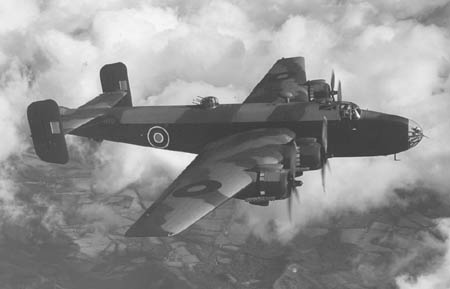
|

|
|
The
Halifax Bomber |
Fires marking the site of a drop zone. |
The
cause of this crash landing was given to me in 1999 following
eyewitness testimony by the mayor of Forges. A DCA was set up in
the area of Forges, like the many others at Bois Roussel, at the
place called ‘Les Fontaines’. The Germans suspected the
presence of a parachute drop zone in this area (and in the
surrounding areas) so they laid a trap by starting several fires
to make it appear like a drop zone for containers of weapons and
ammunition.
The
pilot of
Halifax
, lured by the presence of these fires, reduced
engine speed to go to a lower altitude and prepare for landing.
The German flak left no escape route for this plane and shot it
down. The names of the members of crew were unknown for a long
time.
In
searching for the families, in 2003 I found Tom and Elsie
Linning on a genealogy website. They mailed me the photograph of
the one of the members of the crew, William Edward Linning, 24
years of age, Royal Canadian Air Force Squadron, 298 RAF (a
close cousin of Tom Linning). William was a flying officer,
wireless operator and machine gunner on board the
Halifax
. 60
years afterwards, they discovered William’s grave and the
circumstances of the crash. The body of William Linning (originally
from
Alberta
) rests
today with his Canadian comrades in the
Bretteville-sur-Laize
Canadian
War
Cemetery
in Calvados.
|

|
|
flying officer William Edward
Linning
|
|
Royal Canadian Air
Force
|
Other
members of crew were: P/O James Foxall Crossley (pilot, aged 24
years); Sgt. Edward Maurice Cyril Wilkinson (flight engineer,
aged 24 years); WO Joseph Wilfred Romeo Fournier (wireless
operator and machine gunner); FO Derwood William Smith
(bombardier, aged 22 years); Sgt. Enzo Biaggio Grasso
(bombardier, aged 23 years); and an airman who has not been
identified.
Thereafter,
I learned that some ten parachute drop sites had been set up
before August 1943 by Edouard Paysant, departmental chief of the
BOA (Bureau des opérations aériennes). Edouard Paysant left
his residence in Sées following the crash landing, on
July 4,
1943
, of a
B17 at Belfonds, and after he had organized and facilitated the
escape of six members of the crew (see the report "Independence
Day" on the ANSA website). Remember that the land around
Montmerrei, Merlerault, and Haras de Rouge Terres not only
received tons of ammunition and weapons, but also several secret
agents, thus preparing and arming the Resistance in anticipation
of the landings on the Normandy beaches on June 6, 1944.
Consequences...
Many arrests of members of the BOA amongst whom were my neighbor,
Albert Frémiot, Place de Parquet in Sées, and our teacher,
Jean Mazeline. After imprisonment in Château des Ducs in Alençon,
both were shot at L’Hôme-Chamodot (Orne) on
August
8, 1944
with
two other Resistance members.
Within
the context of this crash landing, let us remember the arrest
and deportation of more than 20 inhabitants of Sées and the
surrounding area, including four gendarmes of the local brigade.
July
18:
Aerial combat. For us it was an ongoing spectacle. The problem
was that we never knew which side was the winner.
July
20:
A transmitter set in the forest...
A
neighbouring farmer (I never learned his identity), who was a
little tipsy and in a state of panic, arrived at our residence.
He had just found a machine that he could not identify in the
nearby forest. Out
of curiosity, we followed him carefully. The least crackling of
the dead branches underfoot in the silence of the forest
frightened us. No Germans were in sight as the farmer led us
along paths, in shade and half-light, toward the place in the
woods at Léguernay where he found the machine. A white mass was
visible under the branches. At last, to our astonishment, we
discovered under cover of the large trees, a parachute partially
covering a signaling station. Several tubes are broken, and the
glass was scattered on the dead leaves. Our guide attests as
follows.
"Fearing
the device might explode, I hid behind a tree, took a stick and
poked at the box attached to the parachute.
Result... I saw a completely ruined, unusable radio
installation. It was
undoubtedly a radio transmitter, intended for use by local
resistance workers, but one which could never be used.
The
following day two men with serious faces and grim mouths loomed
out of the darkness as we were eating our evening meal. Their
demeanour made us feel uneasy. With carefully-worded questions,
they asked whether we knew anything about the parachute drops in
the surrounding area. We hesitated ….were they Gestapo or
Resistance? This uncertainty brought on by understandable
caution, encouraged us to remain mute in the face of such
precise questions. The unknown men departed, discomfited and
suspicious.
With
the passing of time, I remain convinced that this ruined,
parachuted transmitting set we had found was intended for the
Tessier de Tanville group which had taken refuge in Vingt
Hanaps. We know today that this group, faced with the threat of
an operation [raid] at Tanville, had been obliged for reasons of
safety to leave the place. The mayor and an inhabitant indeed
had been just shot by Germans.
This
group, established at Vingt Hanaps, had to move once again
because of proximity to the airfields of Lonrai and Semallé.
This
was an enormous loss for the Resistance whose quality of radio
communication with the services of the RAF was one of the
measures of success of the missions of supplying weapons and
ammunition. Indeed, the purpose of these night parachute
missions was to provide weapons and ammunition to the Resistance,
within the framework of the plan "tortois”, who were
ready to act following the declaration of the landing by allied
troops...
Ménil
Erreux (note in the area of Essay, by Mr. Paguenet Jacques)
“At
Menil Erreux, which was near the various trunk roads and the
railway lines, military operations were reduced to a snail’s
pace.
At
the end of July, the Germans built a vast airfield (approximately
150 hectares) in the meadows near "Normanderie”, but the
Allies’ control of the skies limited use of this airfield to
only 5 or 6 days... "
July
29: A casualty......
With
his face running with blood, one of the gunners from the DCA
battery arrived to receive some first aid. During a recent
attack by a P47, while he was manning the battery installed in
the place called ‘Les Fontaines’, a shell had hit him in the
left ear. One of his colleagues made him a solid bandage.
In
the distance, rockets rose into the starry summer sky and went
down with infinite slowness.
July
30, 1944
: Sombre Sunday! Crash landing of a
Mosquito!
There
were so many stars in the sky! We slept like a log despite the
course of the events of the day before. A plane buzzed the roof
of our refuge but this time we took the precaution of sleeping
in the cellar, hoping for greater safety. A heavy explosion
caused the house to vibrate. Awakened suddenly, we did not dare
leave our shelter.
|
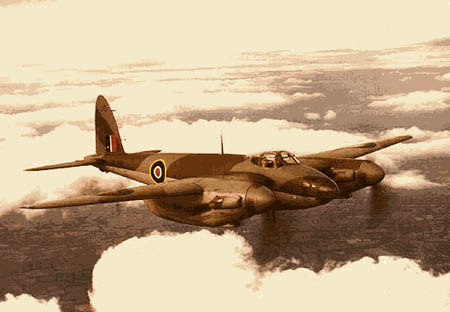
|
|
The
De Havilland Mosquito |
July
31, 1944
: Discovered wreck...
At
dawn, around 6 in the morning, a German gunner we knew pounded
on our door and made us understand that a plane had crashed near
the road. My curiosity prompted me to follow him and he did not
object. A thicket covering one half hectare was blackened by
flames and scattered metal pieces of the plane were still
smoldering. In front
of us, the badly mutilated bodies of the two occupants, the
pilot and the navigator, rested in the middle of a mass of
branches. With a single word, the German made me understand that
the aircraft was a Mosquito night fighter from the RAF, shot
down by the local DCA. He drew an identity card from the tunic
of the one of the victims and held onto it... could he intend to
give it to the Red Cross?
Needless
to say, this drama saddened us, since we knew that the Allies
were making progress on all fronts. The problem was to know how
our area will be freed and with what results for all of us.
The
Germans were not long in appearing. Two days later, after
collecting the bodies of the victims, they organized a hasty
burial at the edge of our garden, within a few meters of us.
In spite of our insistence, they refused to let us be
present. A platoon of soldiers was already there at the burial
site.
A
fusillade disturbed the silence of our countryside. The emotion
was overwhelming.
This
hasty ceremony proceeded before our eyes, as we stood in
silence.
This
section refers to Frank Carr, Flying Officer (VOR), aged 24
years, Royal Volunteer Reserve, of Swinton Manchester; and
Robert Henry Clark, Flight Lieutenant, aged 24 years, Royal
Volunteer Reserve (parents living in Fulham, London), both of
the 487th Squadron of Royal New Zealand Air Force.
|
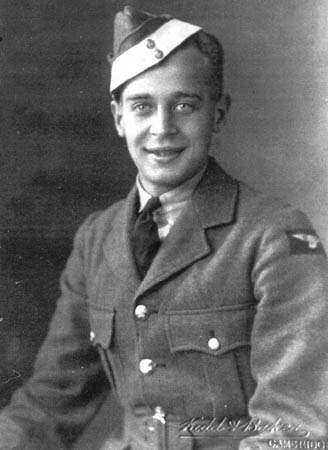
|
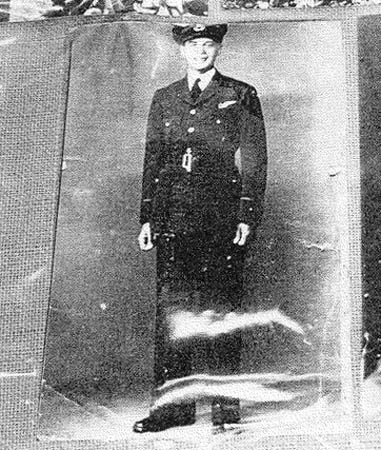
|
|
Flying
Officer ( Nav ) Frank
Carr
|
Flight
Lieutenant Robert Henry Clark
|
|
No
487 Squadron, Royal New Zeland Air Force |
April
14, 1996
- Bursard
A
pale sun breaks through the fog... It is just
midday
.
A
plain marble gravestone, isolated in a corner of the cemetery
(on the left) with this epitaph: "To the glorious memory of
Flying Officer Francis Carr, No 148458, October 27, 1919 - July
30, 1944, and Robert Henry Clark, No 487 Squadron RNZAF,
February 16, 1920 - July 30 1944, Fallen in an aerial combat, in
the woods of la Garenne, Bursard, Orne.
RIP"
"The other
generations might possess
shame and menace. Free in years to come
a richer heritage of happiness
hey marched to that heroic martyrdom.”
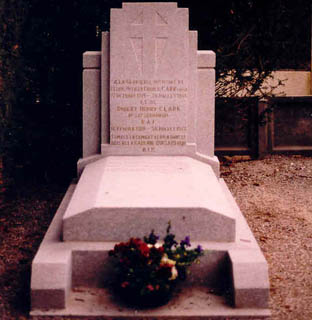 |

|
|
Tomb of Frank Carr and Henry Clark, to the bottom of the cemetery of
Bursard. |
Cross situated at the scene of the crash, in the wood of "la Garenne". |
|
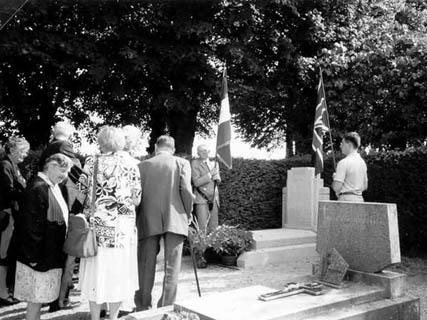
|
|
Commemoration of the fiftieth anniversary in 1994.
|
1st
August: An unknown General.... Leclerc
It
is a surprise! Listen to BBC. A French division has landed in
Normandy
. One name comes up frequently... Leclerc
A
distant voice is heard, despite the jamming. It announces the
disappearance of Sainte Exupéry in the
Mediterranean
. For me it is the evocation of "Southern
Mail" [Courrier Sud], "Night Flight" [Vol
de nuit], "Wind, Sand and Stars" [Terre des
hommes], and "The Little Prince" [Le Petit
prince].
August
12, 1944
: At last!
Absolute
joy... The liberation of our sector proceeded without too many
problems. On the other hand, the Germans, in their hasty
departure, spiked all the DCA batteries that surrounded our town
hall, abandoning an impressive quantity of material. Under one
of the batteries... a package of photographs fallen from a
wallet. I took it upon myself to recover them. They would
furnish my family album. On one of them, infantrymen of the
Luftwaffe pose on the gun mount for an anonymous photographer.
The gunner proudly holds a shell in his arms, ready to inject it
into the cylinder head. Memories of war in the countryside that
will never reach the families....
|

|

|
|
A cannon of Flak sabotaged by the Germans before their precipitate
departure. |
A photo memory of the servers of the Flak battery recovered by Roger Cornevin. |
|

|
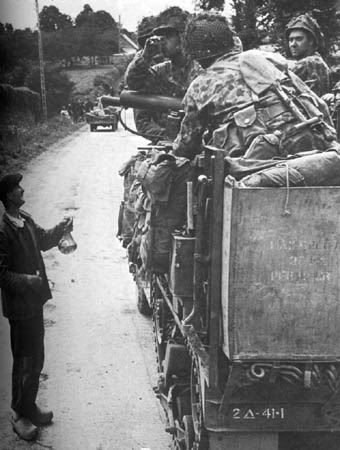
|
|
Jean
and Roger
Cornevin. |
The liberators welcomed by the Norman population. |
In
Key West, Florida in 1962 I met an American officer who told me,
filled with enthusiasm, that he had taken part with the
Patton’s 3rd army in the breakthrough at Avranches, and then
in the liberation of the villages surrounding the area of
Alençon. Under the heat of an August sun, feeling the effects
of many glasses of "apple-brandy", he had not been
able to complete his journey. He added, however, “the green
hedges of Normandy are something I will never forget ! At the
junction of each hedge, there was an ambush !” Did
he speak about the enemy or the apple-brandy?
|
Thank you to ask for the author's authorization for a partial or complete publication of this narration
|
|